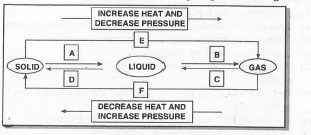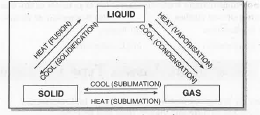Complete Solutions to Example of chapter MATTER IN OUR SURROUNDINGS of Class 9 book with complete answers and questions
| Class 9 | CHEMISTRY |
| Chapter | MATTER IN OUR SURROUNDINGS |
| MBD | Example |
| Number Of Questions | 100 |
| Academic Year | 2023-24 |
What is matter?
View SolutionGive reason for the following observation: The small of hot sizzling food reaches you several metres away, but to get the smell from cold food you have to go close.
View SolutionA diver is able to cut through water in a swimming pool, which property of matter does this observation show.
View SolutionWhat are the characteristics of the particles of matter?
View SolutionThe mass per unit volume of a substance is called density.(density=mass/volume). Arrange the following in order of increasing density -air, exhaust from chimneys, honey water, chalk, cotten and iron,
View SolutionTabulate the diffrence in the characteristics of states of matter.
View SolutionComment upon which of the following are matter: rigidity, fludity, filling a gas container, shape, kinetic energy and density.
View SolutionGive reason : A gas fills completely the vassel in which it is kept.
View SolutionGive reason : a gas exerts pressure on the walls of the container.
View SolutionGive reason : A wooden table should to be called a solid.
View SolutionGive a reason : We can easily move our hand in air but to do the same in solid block of wood we need a Karate expert.
View SolutionLiquids generally have lower density as compared to solids. But you must have observed that ice floats on water. Find out why?
View SolutionConvert the following temperature to celsius scale: 300 K ?
View SolutionConvert the following temperature to celsius scale: 573 K ?
View SolutionWhat is the physical state of water at: `250^@ C` ?
View SolutionWhat is the physical state of water at: `100^@C` ?
View SolutionFor any substance, Why does the temperature remain constant during the change of state?
View SolutionSuggest a method to liquefy atmospheric gases.
View SolutionWhy does a desert cooler cool better on a hot dry day ?
View SolutionHow does the water kept in an earthen pot (matka) become cool during summer ?
View SolutionWhy does our palm feel cold when we put some acetone or petrol or perfume on it?
View SolutionWhy are we able to sip hot tea or milk faster from saucer rather than a cup ?
View SolutionWhat type of clothes should we wear in summer ?
View SolutionConvert the following temperature to the Celsius scale : 293 K
View SolutionConvert the following temperature to the Celsius scale :470 K
View SolutionConvert the following temperatures to the Kelvin scale : `25^@ C`
View SolutionConvert the following temperatures to the Kelvin scale : `1373^@ C`
View SolutionGive reason for the following observations: Naphthalene balls disappear with time without leaving any solid.
View SolutionGive reason for the following observations : We can get the smell of perfume sitting several metres away.
View SolutionArrange the following substances in increasing order of forces of attraction between the particles— water, sugar, oxygen.
View SolutionWhat is the physical state of water at :`25^@C`
View SolutionWhat is the physical state of water at :`0^@ C`
View SolutionWhat is the physical state of water at :`100^@ C`
View SolutionGive two reasons to justify that :Water at room temperature is a liquid.
View SolutionGive two reasons to justify that :An iron almirah is a solid at room temperature.
View SolutionWhy is ice at 273 K more effective in cooling than water at the same temperature ?
View SolutionWhat produces more severe burns : boiling water or steam ?
View SolutionName A, B, C, D, E and F in the following diagram showing state change

View SolutionGive important characteristics of solid state.
View SolutionGive important characteristics of the liquid state.
View SolutionGive important characteristics of gas.
View SolutionGive the main postulates of kinetic theory of matter.
View SolutionDistinguish between solids, liquids and gases.
View SolutionHow will you explain the three states of matter on the basis of Kinetic Model ?
View SolutionDefine the terms given below and answer the questions associated with them.Sublimation: Which of the following substances sublime ?Ice,mercury,dry ice, iodine.
View SolutionDefine the terms givenbelow and answer the questions associated with them.Solid:Whydonot solids diffuse in one another?
View SolutionDefine the terms given below and answer the questions associated with them. Liquid :Why doliquids flow ?
View SolutionDefine the terms given below and answer the questions associated with them.Freezing point: What is the freezing point of water?
View Solution. Define the terms given below and answer the questions associated with them.Gas :Why are gases compressible and show diffusion ?
View SolutionWhat are the necessary conditions for a substance to be a solid?
View SolutionWhat are the necessary conditions for a substance to be a Liquid ?
View SolutionWhat are the necessary conditions for a substance to be a Gas?
View SolutionWhat are the two new states of matter in addition to solid, liquid and gases states ?
View SolutionHeat, light, shadow, love, radio waves are not considered as matter, why ?
View SolutionSolids have definite shapes and volumes, why ?
View SolutionWhy is sponge solid although it can be compressed ?
View SolutionRubber band can change its shape, is it a solid ?
View SolutionIndicate which of the following don't constitute matter ? Car, truck, heat, light, sound, TV waves, radio waves, cement, love, hate, cotton cloth, rock.
View SolutionWhat happens when the vacant spaces between the particles of a liquid decreases ? How is this possible ?
View SolutionWhy do we observe water droplets on the outer surface of a glass containing ice cold water ?
View SolutionWhy should we wear cotton clothes in summer ?
View SolutionName the change of state during the following changes :Drying of wet clothes.
View SolutionName the change of state during the following changes :Melting of wax when kept in sunshine.
View SolutionName the change of state during the following changes : Melting of ice.
View SolutionName the change of state during the following changes : Formation of cloud.
View SolutionName the change of state during the following changes : Naphthalene balls become smaller when kept in air.
View SolutionState your observations in the following cases : Ammonium chloride is heated in a hard glass test tube.
View SolutionState your observations in the following cases : Carbon dioxide is compressed to 70 times the atmospheric pressure.
View SolutionWhat is the difference between gas and vapour ?
View SolutionWhy does a gas fill the container completely ?
View SolutionHow is the liquid state different from the gaseous state ?
View SolutionComplete the following statements : The process of liquid changing into solid is called........ .
View SolutionComplete the following statements : The process of gas changing into liquid called......... .
View SolutionComplete the following statements : The process of liquid changing into gas is called....... .
View SolutionComplete the following statements : The temperature at which a solid changes into a liquid is called ..... .
View SolutionWhat are the uses of interconversion of matter ?
View SolutionGive the important properties on the basis of which the three states of matter can be distinguished.
View SolutionWhat is the importance of (a) melting point of solid and (b) boiling point of a liquid ?
View SolutionGive two differences between boiling and evaporation.
View SolutionName five substances which are solids, five substances which are liquids and five substances which are gaseous at room temperature.
View SolutionRepresent interconversion of states by using a figure.

View SolutionState what is observed when iodine is heated in a test tube
View SolutionWhy do gases have neither a definite shape nor a definite volume ?
View SolutionGive an experiment to prove that gases are more compressible as compared to liquids.
View Solutionwhich phenomenon occurs during the following changes : Size of naphthalene balls decreases
View SolutionWhich phenomenon occurs during the following changes : Wax melts in the sun
View SolutionWhich phenomenon occurs during the following changes : Drying of wet clothes.
View SolutionWhich phenomenon occurs during the following changes : Formation of clouds.
View SolutionWhy do things around our surroundings look different ?
View SolutionDefine matter.
View SolutionGive five examples of matter.
View SolutionWhat are Panch Tatva ?
View SolutionName the Panch Tatva ?
View SolutionHow many basic elements were there according to ancient greek philosophers ?
View SolutionWhat are the basic elements according to greek philosophers ?
View SolutionHow do modern day scientists classify matter ?
View SolutionHow is matter produced ?
View SolutionWhy does a large volume of water get coloured due to a few crystals of potassium permanganate ?
View SolutionHow small are particles of matter ?
View SolutionWhat is in between particles of matter ?
View Solution
Example questions and complete solutions for chapter MATTER IN OUR SURROUNDINGS of MBD of Class 9